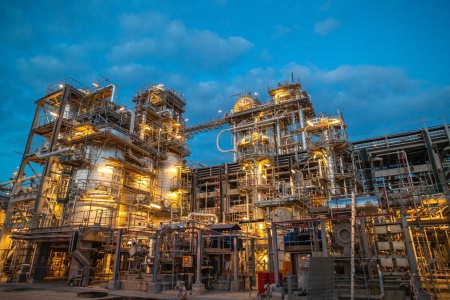
Concrete action in decarbonizing the cement industry
11th Apr 2022
While the window to secure a livable future is rapidly closing, the cement industry has a critical role in avoiding the worst impacts of the climate crisis. Karl Downey, Senior Technical Manager and Team Lead for the SBTi’s Buildings, Cement and Steel Projects, explains what the SBTi is doing to support cement companies in the transformation to net-zero.
Cement has long been an essential construction material that has been in use since ancient times. Egyptian and Roman constructions such as the pyramids, the Colosseum in Rome and the aqueducts, were built with ancient formulas similar to the cement we use today.
Nowadays, concrete - whose key component is cement - is the second-most consumed substance on Earth after water, with half a ton of cement being used each year for every person on the planet.
However, the cement sector is also the second-largest industrial greenhouse gas emitter. As such, it is among the industries with a critical role in tackling the climate crisis; a crisis that the most recent IPCC report has projected to get worse and the negative impacts more frequent with every fraction of warming if urgent action is not taken.
That is why the Science Based Targets initiative (SBTi) has launched our cement sector project. This will enable cement and concrete companies, as well as other potential users of cement, such as construction businesses, to set near- and long-term science-based targets in line with 1.5°C through tools and guidance that take into account sector-specific barriers and opportunities.
Concrete climate actions
On March 16, the SBTi opened a month-long public consultation period to receive feedback from experts - in science, business, academia and civil society - on the Cement Science Based Target Setting Guidance and Tool. This is to guarantee the criteria and guidance are robust, clear, and practical, and provide business leaders with confidence that their decarbonization strategies are in line with climate science.
The need for these resources grows more urgent by the day: the International Energy Agency (IEA) has made it clear that if we are to minimize human suffering from the impacts of global warming, the cement sector must cut its CO2 emissions by 3% per year by 2030 to get on track with the Net Zero Emissions by 2050 scenario.
Who is this guidance for?
The SBTi Cement Guidance lays out how companies within the cement value chain can develop their near- and long-term science-based targets. This includes:
Clinker, cement, and concrete manufacturers
Companies in the value chain that do not produce their own clinker or cement
Other potential users such as construction businesses
Producers of novel binders and cement substitutes
Through the cement target setting tool, companies within the cement value chain will be able to calculate, for their particular cases, what their targets should be to align their emissions reductions with 1.5°C.
What’s more, this guidance has been designed for those companies that purchase cement and whose emissions are part of their scope 3 emissions. Instead of using the generic scope 3 methods, they will be able to use the cement pathway to set targets that cover their cement procurement.
How do cement companies account for their GHG emissions?
To account for their GHG emissions, we will encourage companies within the cement industry to use the definitions found in the Cement CO2 Protocol, which offers more specific accounting guidance for the sector. In additional, as for all science-based targets, they should follow the GHG Protocol’s Corporate Accounting and Reporting Standard and Corporate Value Chain (Scope 3) Standard,
Will companies in the cement industry be required to set scope 3 targets?
Yes: If a company’s scope 3 emissions are 40% or more of total scope 1, 2 and 3, the business is required to set a near-term scope 3 target that covers 67% of its total scope 3 emissions. Additionally, long-term net-zero targets must always include scope 3 emissions. The draft guidance now out for consultation proposes that cement companies also be required to set near-term scope 3 targets covering upstream emissions from all fuels types (i.e. extraction, refining and distribution of fuels before they are burnt in the cement plant), including waste-derived and biomass fuels.
We also recommend companies include scope 3 targets on purchase of cement and clinker. This is to ensure that there is the same level of ambition between the clinker and cement purchased and that which is produced by the company. It will encourage similar target boundaries between companies that mostly buy such materials and those that mostly produce them.
How should the cement industry deal with emissions from waste-derived fuels?
The Cement Science Based Target Setting Guidance is clear: near- and long-term targets must always be based on the “gross” emissions of a company; that is, emissions from combustion of waste-derived fuels shall be included in the emissions covered by cement scope 1 for all years.
Will breakthrough technologies be accepted in the mitigating process?
To cut emissions at the pace and scale needed to prevent the most devastating impacts of climate breakdown, the industry will require a broad set of mitigation options going beyond current practices. This will include deploying innovative technologies such as carbon capture and permanent geological storage (CCS) to drive down energy and process emissions; and increasing material efficiency.
We will recommend that cement companies submitting near- or long-term targets provide evidence that they are taking action to ensure breakthrough technology needed to meet their target ambition will become available in the timeframe expected.
Further guidance on Carbon capture and use (CCU) is due to be developed in the SBTi’s upcoming work on Beyond Value Chain Mitigation.
How might offsetting and avoided emissions be used to meet SBTi goals?
Offsets are only considered to be an option for companies wanting to make additional investments in mitigation activities beyond their science-based targets. These are not considered as a substitute for emission reductions (see the SBTi Net-Zero Standard). Once a company cuts at least 90% of its emissions to meet its long-term target, the residual emissions that remain unabated must be neutralized through the permanent removal and storage of carbon from the atmosphere to reach net-zero.
Emission reductions that occur outside of a product’s life cycle or value chain, but as a result of the use of that product - that is, avoided emissions - are not counted towards science-based target setting and must be reported separately from scope 1, 2 and 3 emissions.
What are the cement project milestones?
On April 15 the public consultation will close. We will then review feedback and revise the guidance in response. In June 2022 we plan to launch the Cement Science Based Target Setting Guidance and Tool.
Please note that after July 15 2022, well-below 2°C targets will no longer be accepted for validation, and companies setting targets will be required to align with the 1.5°C scenario.
The time to act is now
We are facing a turning point in history: unless the world immediately and dramatically cuts emissions in the next eight years, we will not prevent a climate catastrophe.
The latest draft of the Cement Science Based Target Setting Guidance can be found here, as well as the tool. Please provide feedback through this survey.



